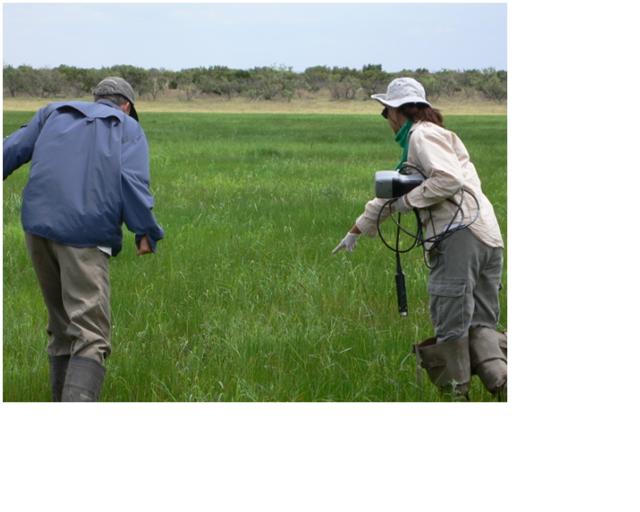Occurrence, Function, and Conservation of Playa Wetlands: The Key to Biodiversity of the Southern Great Plains

Lacrecia Johnson, Ph.D. 2011, Texas Tech University
Project Supervisor:
Dr. David Haukos
Funding:
EPA
Texas Tech University
U.S. Fish and Wildlife Service
Cooperators:
Dr. Loren Smith
Dr. Scott McMurry
Location:
Texas, New Mexico, and Oklahoma
Status:
Completed
Objectives:
(1) Evaluate physical loss and modifications of playas as a function of anthropogenic impacts.
(2) Develop the framework of a functional assessment for Great Plains playa wetlands
(3) Estimate the effect of the USDA soil classification and subsequent mapping of upland and depressional soils in the SHP of Texas.
(4) Quantify the effectiveness and impact of vegetative buffers of different widths and vegetation structure around playa wetlands on concentrations of metals, nutrients, and sediment in precipitation runoff and total volume of water entering playas.
Progress and Results:
Playas form the primary wetland system in the High Plains portion of the Southern Great Plains (SGP) and provide valuable ecosystem services and functions including being key sites for biodiversity. Current estimates of the number of playas within the SGP (Texas, New Mexico, Oklahoma, southwestern Kansas, southeastern Colorado) from historical soil surveys (pre-1970s), topographic maps, and field checks exceed 25,000. This number often gives the potentially mistaken impression that there are numerous, adequately functioning playas in the region that continue to meet ecological and societal needs. In addition, these historical estimates are used to generate samples of playas for a variety of natural resource survey and research efforts, which depend on the occurrence of functional playas to generate sound inferential results. During the time period of 1970-2008 an estimated 17% of playas have been physically lost from the SGP landscape. Through the application of the function matrix, none of the sampled playas were estimated to function at full functional capacity in the SGP. Seventy-three (47%) of playas were estimated to be partially functional and restorable. Partially functional and non-restorable due to cost playas were estimated at 12.9% or 20 playas, and 61 (39.4%) playas were partially functional and non-restorable because effective restoration techniques do not exist. The effect of buffers surrounding playa wetlands on water quality was evaluated as functions of buffer width and vegetation cover. TDS and TSS reached a combined maximum removal at 50 m, 49% and 72% respectively. Nitrate and phosphorus reached a combined maximum removal at a distance of 20 m, 49% and 33% respectively. Maximum removal of metals occurred at 40 m. Estimated percent reduction in runoff reaching the playas due to the presence of a buffer was greatest for the native CRP cover type (-5.8%). A minimum buffer width of 40-50 m is necessary to maximize contaminant removal from runoff entering playa wetlands.
Products:
Dissertation:
Johnson, L. 2011. Current status and function of playa wetlands on the Southern Great Plains. Dissertation, Texas Tech University, Lubbock, Texas.
Publications:
Haukos, D.A., Johnson, L.A., Smith, L.M. and McMurry, S.T., 2016. Effectiveness of vegetation buffers surrounding playa wetlands at contaminant and sediment amelioration. Journal of Environmental Management, 181, pp.552-562.
Daniel, D.W., L.M. Smith, D.A. Haukos, L.A. Johnson, and S.T. McMurry. 2014. Land use and Conservation Reserve Program effects on the persistence of playa wetlands in the High Plains. Environmental Science and Technology 48:4282-4288.
O'Connell, J., L. Johnson, B. Beas, L. Smith, S. McMurry, and D. Haukos. 2013. Predicting dispersal-limitation in plants: Optimizing planting decisions for isolated wetland restoration in agricultural landscapes. Biological Conservation 159:343-354.
O'Connell, J., L. Johnson, L. Smith, S. McMurry, D.W. Bees, and D. Haukos. 2013. Effects of agriculture tillage and sediment accumulation on emergent plant communities in playa wetlands of the U.S. High Plains. Journal of Environmental Management 120:10-17.
O'Connell, J., L. Johnson, L. Smith, S. McMurry, and D. Haukos. 2012. Land-use and conservation programs on wetland plant communities of the semi-arid United States Great Plains. Biological Conservation 146:108-115.
Johnson, L.A., D.A. Haukos, L.M. Smith, and S.T. McMurry. 2012. Loss and modification of Southern Great Plains playas. Journal of Environmental Management 112:275-283.
Johnson, L.A., D.A. Haukos, L.M. Smith, and S.T. McMurry. 2011. Jurisdictional loss of playa wetlands caused by reclassification of hydric soils on the Southern High Plains. Wetlands 31:483-492.
Technical Report:
Johnson, L., D.A. Haukos, L.M. Smith, and S. McMurry. 2011. Current status and function of Southern Great Plains playas wetlands and evaluation of buffer effectiveness: Implications for future conservation efforts. Final Report U.S. Environmental Protection Agency Cooperative Agreement CD-966441-01-0, Playa Lakes Joint Venture Project #445, U.S. Fish and Wildlife Service/U.S. Geological Survey Cooperative Agreement # 1434-HQ-07-RM-0068; TCRWFU RWO 67.
Professional Presentations:
Haukos, D.A., L.A. Johnson, L.M. Smith, and S. McMurry. 2011. Effectiveness of vegetative buffer areas surrounding playa wetlands. Ecology of Waterbird Migration and Playa Wetland Ecology Symposia, Rainwater Basin Joint Venture/Playa Lakes Joint Venture Research Symposium; Annual Meeting of The Waterbird Society, Grand Island, Nebraska.
O'Connell, J., L. Smith, S. McMurry, and D. Haukos. 2011. Effects of land management on plant communities of playa wetlands. Ecology of Waterbird Migration and Playa Wetland Ecology Symposia, Rainwater Basin Joint Venture/Playa Lakes Joint Venture Research Symposium; Annual Meeting of The Waterbird Society, Grand Island, Nebraska.
Johnson, L., D. Haukos, L. Smith, and S. McMurry. 2010. Effectiveness of wetland buffers as a conservation tool for playas. 46th Annual Meeting of the Texas Chapter of The Wildlife Society, Galveston, Texas.
O'Connell, J., L. Smith, S. McMurry, and D. Haukos. 2010. Conservation effects of catchment land management on playa communities of playa wetlands in the short-grass prairie ecoregion. Annual Meeting of the Society of Wetland Scientists.